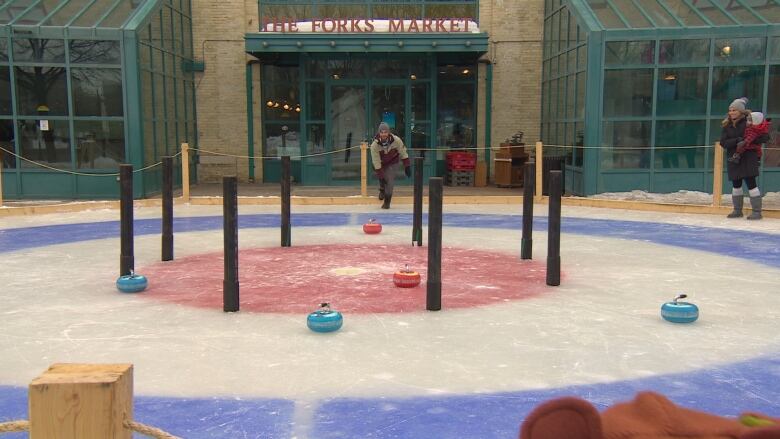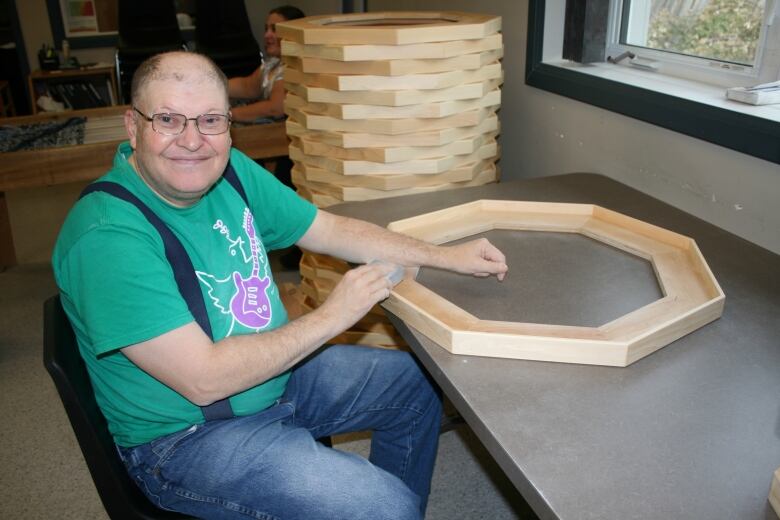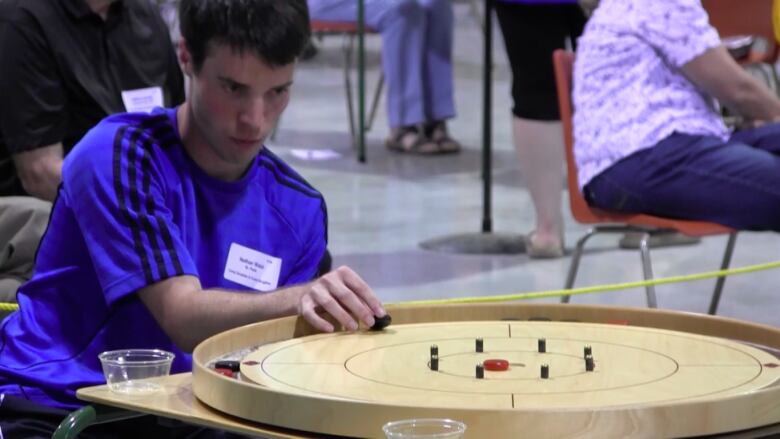A Manitoba pastime? The history of crokinole
Long before crokicurling hit the scene, crokinole was the game of choice for many

If you've skated through The Forks in Winnipeg this winter, you might have spotted it: an enormous octagon of ice, with a brightly painted blue target and a red bull's-eye.
It's what may be the world's first crokicurling rink, combining a pair of beloved Manitoba pastimes curling and the board game crokinole into a single, supremely Canadian sport.
But long before you could play it on ice, competitors of all ages and skills have been playing crokinole on boards, in a tradition that goes back decades in the province.
- Hurry hard! New ice game crokicurl debuts in Winnipeg
- Curling and crokinole collide, creating a new ice game in Winnipeg
Richard Neufeld is the general manager of Blue Sky Opportunities in Altona, Man. The agency supports adults with intellectual disabilities.
Since the '80s, Neufeld says they've been making and selling crokinole boards in the woodshop at the Occupational Training Centre. Every year since they started, Neufeld says demand has increased by five to 10 per cent. Funding for the group from the provincehasn't increased in years, he says, so profit from crokinole boards and other wooden projects now keep the agency afloat.

"It's one of those things that it's a cultural I don't know, cultural identity might be too strong a word, but it's just something that continues to captivate the interest of the youth," Neufeld says.
"It's just a part of the culture here."
Played on a large round or octagonal board, crokinole usessmall discs, like checker pieces. Playersslide the pieces from the edge into the centre of the boardusing a flick or push, trying to score points by landing the disc as close to the centre as possible while preventing their opponent from doing the same.
Neufeld says it's long been popular among localMennonite families, butnot everyone is clear on its history.
"There's always been this discussion of, you know, 'Where is the heart of crokinole?'" Neufeld says.
"The [Manitoba] Mennonites like to claim fame to the game. But, I mean the reality is there's Mennonites all over Canada and also in Ontario."
'One of those great mysteries'
According to the Elliot Avedon Virtual Museum of Games at the University of Waterloo, crokinole can be confidently traced back to at least the 1860s in "the Mennonite areas of Ontario."
By 1880, the museum says, a commercial pattern was registered in the U.S.
According to research by journalist Bill Gladding, the earliest-known crokinole board, or croke, was made in Sebastopol, Ont.,just a mile north of a town called Tavistock that is now home to the World Crokinole Championships.
Lore holds the first board was made by local woodsman Eckhardt Wettlaufer from "a good Lutheran family," Calder says as a fifth birthday present for his son.
As the legend goes, Adam, the five-year-old owner of the first-known crokinole board, didn't like it very much.
"He didn't like the game at all, so the board hung on the kitchen wall of the farmhouse for quite a while, hardly ever played," says Sherrill Calder, who sits on the committee for the championships in Tavistock.
Where Wettlaufer got the idea for the board is less clear. Crokinoleis widely believed to stem from a variety of games from around the world, including the 16th-century British games of squails and shovelboard an early version of shuffleboard and the 18th-century Indian or Burmese game of carrom or carroms.
But how the game made its way to Wettlaufer in Ontario is anyone's guess.
"We're a little foggy on that," Calder says. "He obviously had some inkling of it from somewhere, but whether he had played it somewhere or heard of it or whatever not real sure on that."
"[It's] one of those great mysteries."

'Dark, dingy, cigar-filled, smoky pool halls'
Willard Martin, 72,has been making crokinole boards his whole life, taking over from his dad, Manasseh Martin, who made them for a living, too. Between the two of them and his brother Bruce,Martin says his family has been making boards in Elmira, Ont., for half a century.
Martin maintains the game stayed popular amongMennonites because it's not associated with anything objectionable.
"It was the game that we grew with, and the one reason that it was as popular as it is amongst the people that it was, [is] that it was never connotated with the dark, dingy, cigar-filled, smoky pool halls," he says.
"It all has its variations, but the clean, family aspect of it is what made it successful."
The game remained popular in the region for over a century after Adam Wettlaufer turned up his nose at it, thanks, in part, to the work of Wayne Kelly,alsoknown as "Mr. Crokinole."
"Wayne Kelly was the one who really got crokinole going up here," Calder says. "He's the one who really talked it up, got people interested. Really put crokinole on the map."

Kelly died in 2016, but Calder says his mark on the game is lasting. In 1999, he helped set up the tournament that would become the world championships.
"It started off as, 'Have a little tournament,'" Calder says. "And then somebody said, 'Listen, go big or go home. Let's make it the world crokinole championships.' So they did."
Calder says the tournament brings in at least 400 people, without fail, every year on the first weekend of June. Among them are players "from coast to coast" in Canada, she says, and the east coast of the U.S.
Most years, there are a few international players, too, she says. Germany, Poland, France, Italy, Austria and Scotland have all been represented at tournaments gone by.
Calder says she thinks the game is gaining popularity. Three or four years ago,she started noticing more young people turning up at tournaments.
"We still have a lot of kids, you know, who come and play with their parents, with their grandparents," she said. "Safe to say that it's definitely a big hit in universities these days, so we're seeing a lot of that age group, the kind of young, working crowd is kind of big at it."
"It's not just the game, you know, that's sort of sat behind the couch at the cottage that you pulled out on a rainy afternoon."












_(720p).jpg)


 OFFICIAL HD MUSIC VIDEO.jpg)
.jpg)



























































































